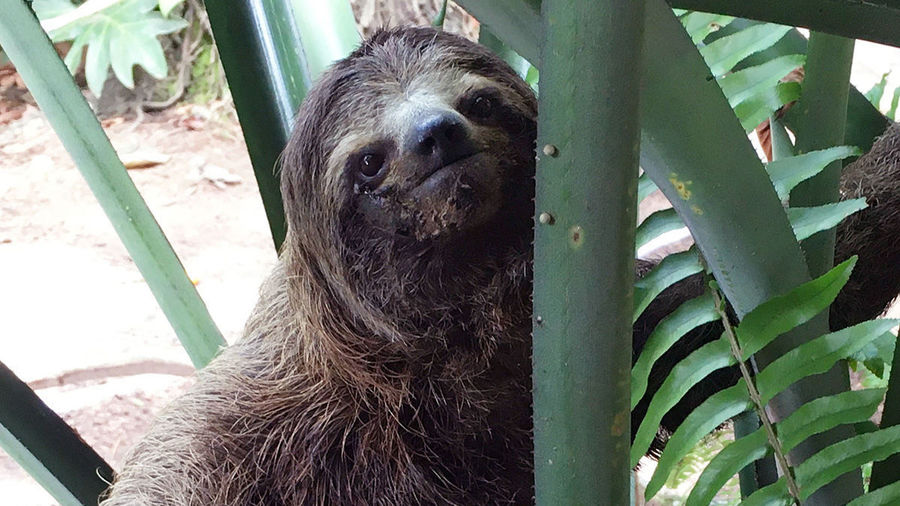

The large clawed sloth was an herbivore, most likely a browser, feeding off of trees and low-lying shrubs. It was also found at a fossil site in the Rocky Mountains 8, 874 feet above sea level.īased on its distribution, it has been suggested that Megalonyx was able to occupy a variety of habitats but may have preferred woodlands and forests including spruce dominated, and mixed conifer-hardwood habitats. It is really well known in most states east of the Rocky Mountains but does occur on the west coast of the United States. Megalonyx has been found in Central America and up into Alaska and the Canadian Yukon.

At some point, one lineage adapted to climbing and spending most of its life in trees, while the other lived primarily on the ground. Megalonyx shares a common ancestor that evolved in South America with its closest living relative, the three-toed sloth. Prior to the formation of the Isthmus of Panama, relatives in the same family of sloths as Megalonyx were able to distribute between South America and islands in the Caribbean. Sometimes this sloth is referred to as “Jefferson’s ground sloth.” Relationships

The first Megalonyx fossils were described by President Thomas Jefferson in 1797, which he thought originally belonged to a giant lion. Like the Shasta Ground Sloth, its front feet bore large claws for grabbing branches and defense. Compared to the Shasta Ground Sloth, Megalonyx and had a more blocky-shaped head with an additional set of peg-like incisors in the upper and lower jaws. The large clawed sloth, or Megalonyx, was a large ground dwelling sloth which grew to about 10 feet long and weighed roughly 2,200 pounds. Megalonyx is one of the two species of giant ground sloth found from Tule Springs Fossil Beds National Monument. Tule Springs Shasta Ground Slothįossils of the Shasta Ground Sloth are rare at Tule Springs Fossil Beds but the species is known from a partial cranium and a few teeth. It probably lived solitarily, only getting together for seasonal mating. It has been speculated that it had the ability to rear up on its hind legs to forage and defend itself against predators. The Shasta Ground Sloth was a slow-moving herbivore like living tree sloths however, it did not climb trees and spent much of its life on the ground.

From fossil dung, paleontologists were able to determine that they ate Joshua tree fruits, desert globemallow, cacti, and yucca, along with other desert plants. The Shasta ground sloth was an herbivore. The Shasta ground sloth inhabited dry, open juniper woodlands, seasonal wetlands, and open woodlands.
Sloth predators full#
Partial mummified ground sloths have been found in desert caves in Arizona and New Mexico, including a cave in Grand Canyon National Park that was full of Shasta Ground Sloth dung. The Shasta Ground Sloth is known from central Mexico through most of the American Southwest. Nothrotheriops was not closely related to two- nor three-toed tree sloths that are alive today in Central and South America Distribution and Habitat The intermittent movement of different types of animals between North and South America throughout the Pliocene and Pleistocene epochs is known as the “Great American Biotic Interchange.” This phenomenon brought today’s opossums, porcupines, and armadillos to North America and today’s foxes, lamine camels (llamas), and small cats to South America. The ancestors to Nothrotheriops evolved initially in South America and then crossed the Isthmus of Panama to North America roughly 2.6 million years ago. The first fossils of the Shasta Ground Sloth were described in 1905. It had a long, slender skull with a narrow mouth that might have supported a long prehensile tongue. The front feet bore large claws for grabbing branches and helping defend itself from large predators. It was approximately 9 feet long and weighed up to 550 pounds. The Shasta ground sloth was a large ground dwelling sloth, but one of the smallest ground sloths to live in North America during the late Pleistocene. The Shasta ground sloth is one of the two species of giant ground sloth found from Tule Springs Fossil Beds National Monument.


 0 kommentar(er)
0 kommentar(er)
